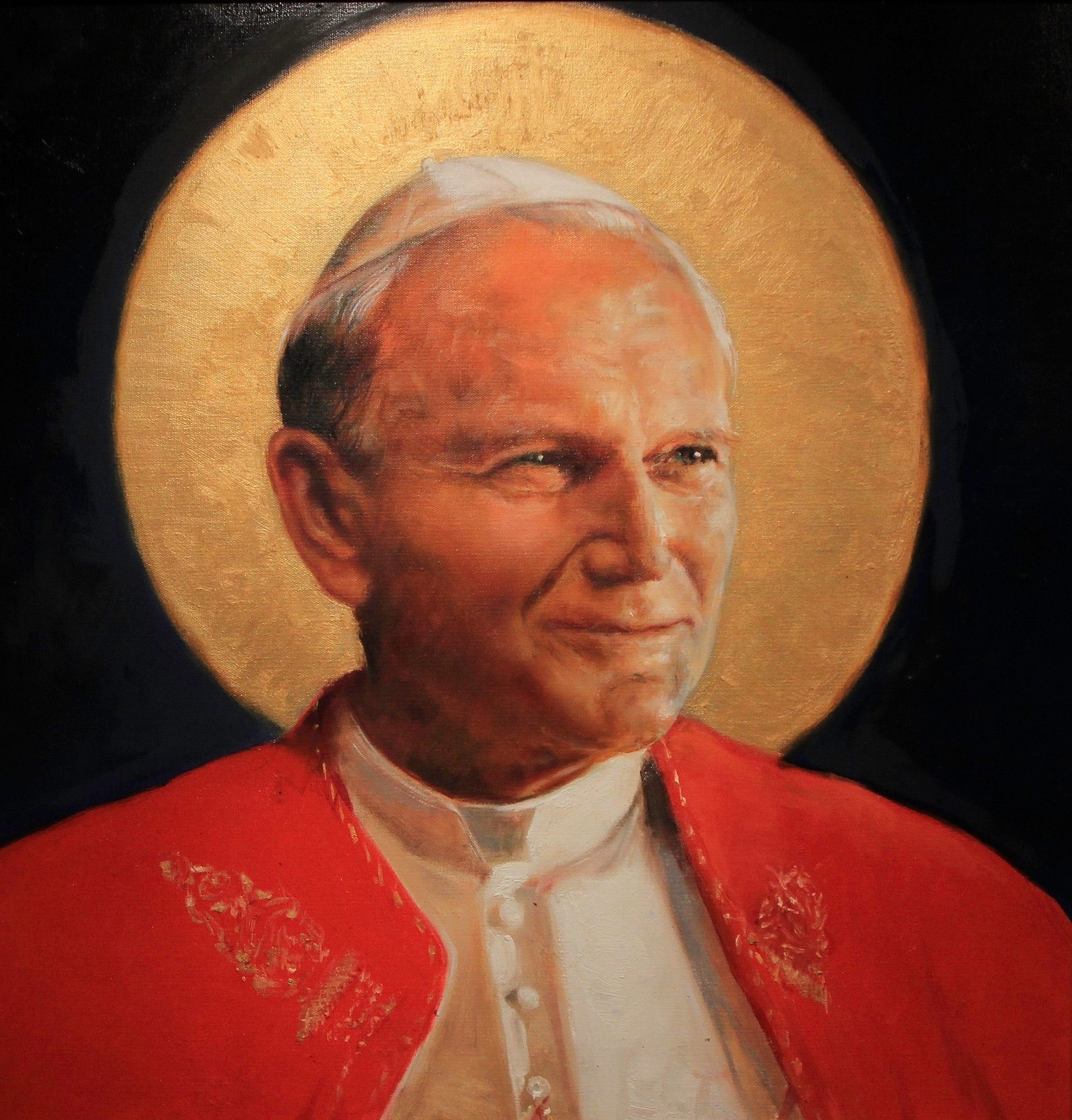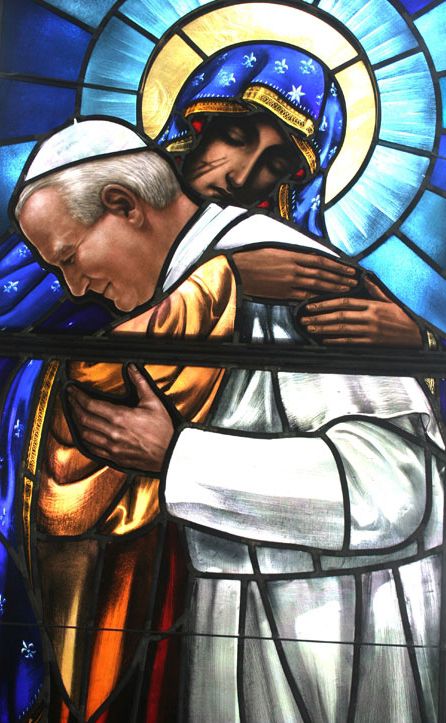St. Pope John Paul II: The Book Was the Turning Point of My Life
Saint Pope John Paul II and Andre Frossard
“Grignion de Montfort introduces us into the very heart of the mysteries on which our faith lives and grows and bears fruit”.
The Turning Point . . .
In the private chapel of John Paul II, high above the High Altar,. . .
there hangs a large crucifix; under one of the arms of the Cross, on the righthand side, where the Stabat Mater is presumed to have taken place, there is a little statue of Our Lady of Czestochowa. The Holy Father’s devotion to Our Lady is well known, based as it is on the Gospel; but it also owes a great deal to a little book which was lost or hidden for a period of 150 years, The Treatise of the True Devotion to the Blessed Virgin, by Louis-Marie Grignion de Montfort, written about 1700 A.D. which adds at the present time, including the Curé of Ars, two more Frenchmen to the religious mentality of the Holy Father:
“Reading this book was to be a turning point in my life. I say turning point, although it was in fact a long spiritual journey coinciding with my clandestine preparation for the priesthood. It was at that time that this remarkable treatise fell into my hands – one of those books which it is not sufficient simply ‘to have read.’ I remember carrying it about with me for a long time, even into the factory, which resulted in the lovely cover being soiled with lime. I kept turning back, time and time again, to certain passages.
. . . in My Life
I soon discovered that over and above the baroque style of the book, there was something fundamental; and the devotion which I had as a child and an adolescent towards the Mother of God gave way to a deeper devotion of faith, as if from the very heart of Trinitarian and Christological realities. “Whereas I had formerly held back, lest my Marian Devotion should detract me from that due to Christ, I understood in the light of reading the treatise of Grignion de Montfort, that the very opposite was the case. Our interior relationship with the Mother of God is the direct result of our being bound up to the mystery of Christ. It is, therefore, not a question of the one preventing us from seeing the other.
“Quite the contrary in fact: the ‘true devotion’ to the Blessed Virgin becomes clearer and clearer to the one who is making progress in the mystery of Christ, the Incarnate Word, and in the Trinitarian Doctrine of salvation which is centered on this mystery. It can be said that Christ Himself points out His Mother to the one who tries to know and love him, as He did to St. John at the foot of the Cross.
Christ Points Out His Mother
“I refer to the episode in the Gospel: ‘Standing by the Cross of Jesus were his mother, and his mother’s sister, Mary, the wife of Clopas and Mary Magdalen. When Jesus saw his mother, and the disciple whom he loved standing near, he said to his mother: Woman, behold, your son. Then, he said to the disciple: Behold, your mother. ‘ The Gospel adds that from that day ‘the disciple took her to his own home.’
The Perfect Devotion
“The ‘perfect devotion to Mary,’ – according to the author of the treatise – i.e. perfect knowledge and confident abandonment of ourselves into her hands, increases with our knowledge of Christ and the confident abandonment of ourselves into his hands. In addition, this ‘perfect devotion’ is indispensable for the one who wishes to give himself unreservedly to Christ and to the work of the Redemption. Grignion de Montfort introduces us into the very heart of the mysteries on which our faith lives, and grows and bears fruit. The more my spiritual life was centered on the reality of the Redemption, the more abandoning myself to Mary, in the spirit of St. Louis Marie de Montfort, appeared to me to be the best way to share fully and effectively in the reality, in order to draw out for myself and to share with others its unspeakable benefits.”
Spiritual authors at the time of Grignion de Montfort . . .
were not all cast in the same mold, yet they all possessed the same style, which the Holy Father called “baroque,” in reference of the times to which they lived and not in the French meaning of the word, meaning everything that is out of line. The “baroque” style of Grignion de Montfort gives the Pope the opportunity to give us an interesting insight on the meaning of freedom!


“This book”, was a decisive turning-point in my life. I say ‘turning-point’, but in fact it was a long inner journey. A journey that coincided with my clandestine preparation for the priesthood. It was at that time that this curious treatise came into my hands. The Treatise is one of those books that it is not enough to ‘have read’. I remember carrying it on me for a long time; even at the sodium factory, with the result that its hand-some binding became spotted with lime.”
Link to The Queen: Articles
Holy Slavery
“This Marian devotion – which I am simply outlining to you today – has since remained a part of me. It is an integral part of my interior life and of my spiritual theology. It is well known that the author of the treatise defines his devotion as a kind of ‘slavery.’ The word may shock our contemporaries. Personally, I see no problem with it. I think that it is a kind of paradox that is often found in the Gospels, the words ‘holy-slavery’ signifying that we cannot make any greater gift than that of our freedom, the greatest gift we have received from God.
“For liberty is measured by the amount of love of which we are capable.
“That, I think, is what the author wanted to tell us. I must add that my most personal and spiritual relationship with the Mother of God has had, from my very youth, its source in the great stream of Marian devotion which finds its origin and its many complementary currents in Poland. Yasna-Gora has borne witness to this tradition during hundreds of years, and more recently still, during the years 1956-66, and ever since.
“I will point out in particular the Marian shrine of Kalwaria, near Cracow and Wadowice, where I was born, and which is so dear to me, and which I visited so often in my youth, and later on as a priest, and then as a bishop. I can tell you that I had found there, in the kind of piety, which is that of the people to which I belong, the same thing that I found in the treatise. “


